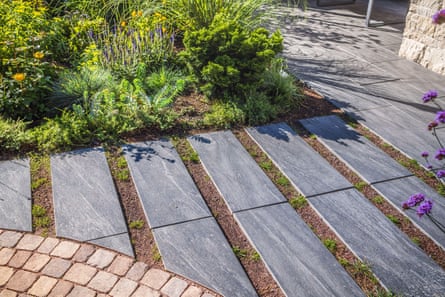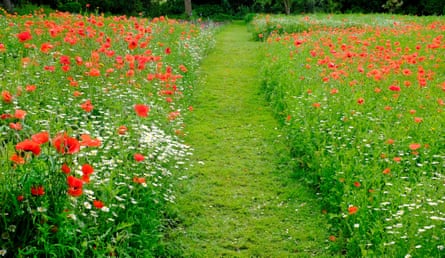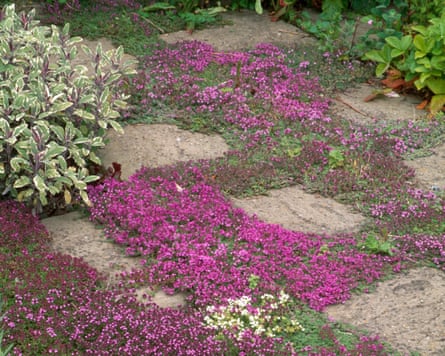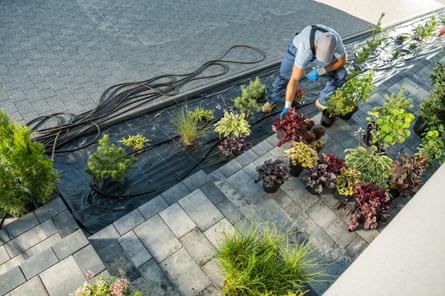When faced with a muddy swamp, or a lawn that needs mowing (again), the most nihilistic among us may dream of concreting over the whole garden – and some turn that dream into reality. A recent report by the Horticultural Trades Association (HTA), which represents garden centres and suppliers, has warned that within the next five years, nearly a quarter of UK householders plan to pave or deck over at least part of their garden, and of those, nearly a third plan to cover more than half of the area. The HTA estimates this could mean a loss of about 8% of the UK’s total private green space, or 409 sq km.
“Paving over gardens with impermeable surfaces has and will continue to undermine urban resilience,” says Prof Alistair Griffiths, the director of science and collections at the Royal Horticultural Society (RHS). Water can’t get through concrete, asphalt and paving, which contributes to surface flooding and overwhelms the sewer system, leading to pollution runoff. Loss of vegetation also contributes to global heating. “We’ve got these increased extremes of heat and if you lose green space, you lose that cooling effect,” he adds. Then there’s the loss of biodiversity that comes from paving over green space – not to mention the impact of a dead, grey landscape on people’s mental health. One RHS study showed that people who nurtured a couple of containers of flowers and a small tree in an urban street lowered their stress hormones as much as if they’d attended eight weekly mindfulness sessions.
So how do you build a low-maintenance garden without decking or paving? Experts reveal their top tips.
Remember paving needs work
Griffiths points out that many people don’t realise you need planning permission to lay an impermeable surface over an area larger than 5 sq metres. He acknowledges that stretched councils are not great at enforcing this, but is that a chance you want to take as you survey your newly laid, neat, lifeless concrete expanse?
That’s not the only possible pitfall. Especially in shaded areas, says Jack Wallington, a landscape designer and the author of A Greener Life, paving slabs get slimed with algae and become slippery. To keep them from becoming a hazard, owners must clean them regularly with a brush and jet washer (or worse, chemical cleaners).
At the house of a friend of mine, a giant colony of rats has moved in underneath the decking, using the space as their headquarters from which to make forays into the house. And my neighbour’s deck houses foxes – wildlife, yes, but perhaps not the kind you want.
Wooden decking also needs to be treated every other year or so, points out Wallington, “to make sure it stays as long-lasting as possible”.
Less is more
It’s not that all paving or decking is bad, says Wallington. “It’s about getting the balance right.” Griffiths points out that paved areas are essential for accessibility. But for most people, says Wallington, “paving an entire driveway or garden is overkill, because they’re never going to use that whole area”. He suggests starting with a 3m by 3m seating area, big enough for a table and chairs, and scaling up or down depending on the size of your garden and how many people will be using it. For an average-sized urban garden, he says, leaving at least 75% as green space is ideal. “It’s good that people have seating areas in gardens, but start off with thinking: could it be on a lawn, or on gravel or bark chips?”

Consider lifting a few pavers or cobblestones here and there, and planting something in the space. “That is usually enough to give you access and livability, while encouraging a bit of life there too,” says Ross Cameron, a professor of environmental horticulture at the University of Sheffield. In a front garden, you could lift the edges of a paved area and plant it up, or leave it “a bit rough at the edges and then nature comes in, things like small growing daisies and clovers and things that will just find their own niche. You could encourage that at the edges and still have a nice clean path up to the front door.”
Or grow upwards. “You could have archways over the drive with an evergreen climber, like a clematis,” says Griffiths. “During frost periods, when you get ice on the car windscreen, a climber could actually help to reduce that by having a bit of a warming effect.”
Re-green your driveway
While resin driveways have become fashionable in recent years, they are essentially made from plastic. There’s no reason why you can’t grow on a driveway, says Griffiths, pointing out that you only need enough paving for four tyres. “You could incorporate low-growing plants that you can drive over and they will still grow.” He suggests trying ivy, thyme or creeping jenny.
Grow a meadow

“A meadow is a really low-maintenance option,” says Kate Bradbury, a garden writer and the author of One Garden Against the World. “You could let your grass grow long and leave it wild and cut it once or twice a year, instead of weekly in summer. It will become a really biodiverse place. Very quickly, you’ll get loads of insects using it – small mammals, birds.” Her tiny front garden is “a mini meadow. I have sparrows stripping seeds off my grasses, and it’s really nice to see. We’ve lost 97% of our meadows since the second world war, and this habit of locking away life is really sad.”
Rethink your lawn
People may go to the drastic step of paving over their garden if the lawn becomes a quagmire. “For most people, in smaller or urban gardens that are heavily used by kids or dogs, the number one rule with lawns is: if it’s really wet, try not to use it, because that’s when it starts to fall apart,” says Wallington. “In the winter, when it’s really sodden and you start treading on it, it compacts the mud and can damage plant roots in the lawn. Perhaps take the kids to the park, rather than using the lawn, in those wettest weeks.”
Ensure you’ve chosen the ideal grass – special mixes for shadier spots, for instance. “Tough grasses are used for sports pitches, which might be good for heavily used lawns.” Don’t weed the lawn, Wallington adds, because things like dandelion, yarrow and other wild plants make it much more resilient. “Some of these plants are really drought-tolerant. In summer, when the grass dies back, you’ll find that they’ll be the ones that stay green.”

If you prefer a neat and lush look, rather than a meadow, you will need to mow weekly in early summer, says Wallington. “That allows the sun to get down to all of the plants, which keeps it tightly knit.” But it needn’t be too arduous – get a mulching blade for your mower and you won’t need to collect the clippings. “It whizzes all the grass up into small bits and puts it back on to the ground, adding nutrients.”
If you have a sunny garden, consider replacing traditional grass altogether, says Bradbury. “You can turn your lawn into a thyme or chamomile lawn, but only if you don’t tread on it very often, so I would say don’t do this if you’ve got kids.” She recommends Chamaemelum nobile “Treneague”. “It grows to about 10cm in height, and it has a spreading habit. Creeping thyme needs a very well-draining soil and sunshine, but doesn’t grow very tall, and does flower, so it looks pretty.”
Lawns as we know them, Bradbury points out, are less eco-friendly in the long term. “With our dry summers, they just go brown and look horrible, and then people water them, and that’s not sustainable.”
Or get rid of it altogether
“There’s so many more interesting things to do,” says Bradbury, than tend to your lawn. Gravel gardens are easy to look after, she points out. You’ll need a weed-suppressing water-permeable membrane, but you can get ones made from natural fibres such as jute, rather than plastic. “Cut holes in the liner, plant into it, and then surround everything with gravel. You can grow lots of plants that are pollinator-friendly, and drought-tolerant plants. That is really low maintenance, because you don’t have to water the plants as the gravelly mulch holds moisture. In winter, the gravel actually can help protect plants that don’t like waterlogged soil.”
The fashion for large borders is another reason to encroach on the lawn. “There’s loads of advice, either online or in books, on how to plant lower-maintenance big, deep planting areas, which are beautiful throughout the whole year,” says Wallington. “It breaks my heart when you see an entirely paved garden with no planting for wildlife and people.”
Choose robust plants
These are key elements to a low-maintenance garden, says Griffiths. Plant shrubs and trees, “and maybe add in some herbaceous perennials that provide different things”. Consider big ornamental grasses. “They’re still looking beautiful, particularly when you get to autumn and winter, and you get the frost on them.”
Roses are brilliant, he adds. Buy cheaper bare root roses and plant them now. “All you do once a year, with shrub roses, is give them a bit of prune and then every year they come back with beautiful flowers. I’m looking at some now – they’re still flowering.”
Add containers and planters

Where ripping out paving would be impossible, plants in containers will help provide shade, absorb water and encourage biodiversity. “They’ll provide opportunities for pollinators, and insects will get into the containers, and birds can use that,” says Cameron. He adds that there’s a downside: pots can require lots of watering, especially in times of drought. Choose planters that have inbuilt reservoirs to conserve rainwater, or can be attached to downpipes.
Ask why a garden needs to be low-maintenance
Yes, you are swamped with work and the cost of living and caring responsibilities, and it would be useful to have a garden that looks after itself – but perhaps a mindset shift is in order. “Why can’t we invest in our spaces and improve habitats and improve our mental and physical health at the same time?” asks Bradbury.
Discover what you like to do. Mowing the lawn is tedious, she says. “So do something else. If you create a gravel garden and you’ve got lots of lovely flowers, and sometimes those flowers outgrow their space, you go out with your secateurs, and you trim them back. That takes five minutes. You can deadhead things and keep everything looking beautiful, while also having a space that works in harmony with the wider environment.
“Realise how wonderful it is maintaining a garden, and creating these beautiful spaces that nourish our souls, as well as wildlife.”

 3 weeks ago
20
3 weeks ago
20

















































